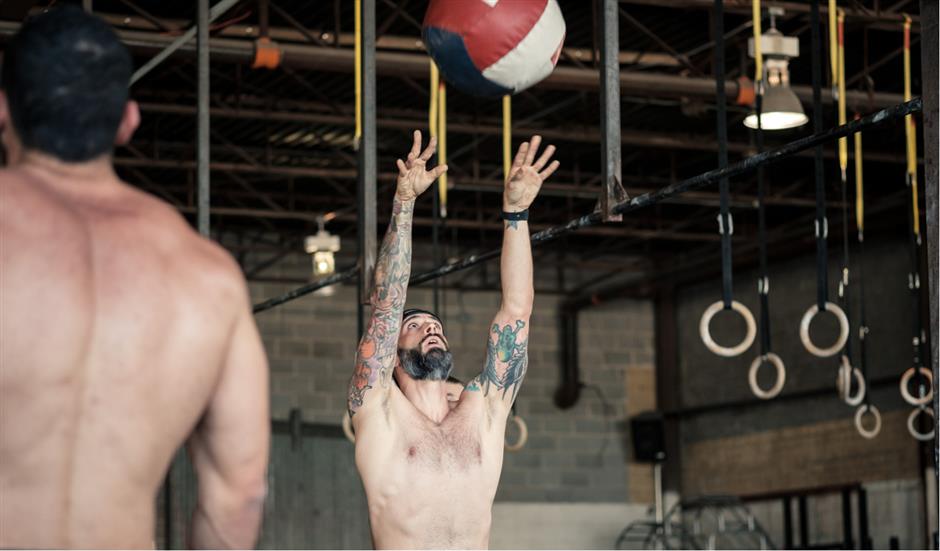
“I definitely could have done that better!”
“I could have pushed harder."
“Now I know how to pace it out better.”
“I’m capable of getting a better score.”
Have you ever finished a workout during the CrossFit Open and received a score short of what you were hoping for? Have you ever felt the need to redo a workout right away because you thought you could have done better?
Many of us look at the CrossFit Open as a time to finally show off all our hard work. The workouts become opportunities to demonstrate what we are capable of, not just to ourselves, but against thousands of other athletes who also face the same test.
Some of our goals may involve finally doing a movement we weren’t able to do last year, such as a muscle-up or double-under. For others at a more competitive level, the goal might be to place within the top 10 in the state or country.
The method of “retesting a workout” has been a strategy for many competitive CrossFit athletes looking to place high in the rankings for a variety of reasons.
Advertisement
Retesting…
- Gives you a “second chance” to show what you can actually do.
- Allows you to use the first attempt as your trial run so you can measure up against your initial performance the second time you complete the workout.
- Allows you to gather data on others’ performances as they are submitted and gives you the opportunity to try and beat another competitor’s score just enough to place higher.
- Shows off your ability to strategize the system alongside demonstrating your highest fitness capacity—if you’re able to utilize multiple opportunities to achieve a higher score, why not?
- Gives you the opportunity to attack the workout differently than you did the first time, now that you have more knowledge and insight on how the workout feels.
The tradition of repeating workouts and seeing how you’ve improved across time has been embedded in CrossFit for years, whether it was the repeat of a common benchmark workout or the re-release of an Open workout that was completed in years past.
Since the CrossFit Open’s existence, there have usually been repeat workouts that reappear on competition day throughout the years, giving athletes who participated in the past an opportunity to see how their current score matches up to their past performance.
For example, workout 13.3 was 12.4. Workout 16.5 was 14.5.
When you retest a workout, you’re repeating the workout against a very short turnaround time as opposed to measuring progress across a longer period of time.
Advertisement
This means your improvement relies more on short-term strategies versus physical improvements that can take weeks or months to reveal. It’s fair to assume that you won’t be as likely to add 50 pounds to your lifts or suddenly be able to string five handstand push-ups together if you were still working on achieving your first one within a few days of the competition.
Questions to Ask Yourself
So, when you’re debating retesting a workout, think about how you can make more strategic adjustments in your performance, and ask yourself these questions:
- What does the appropriate pace feel like from the start to the end of the workout?
- Did I work too hard, or not enough, in the first few minutes or rounds?
- Was my equipment set up efficiently for fast transitions? Was it too crowded for me to utilize the space I needed?
- Did I break up movements into the best rep schemes?
- Did I have the right audience or coach around me to motivate me, or did I feel too distracted?
- Was I really close to getting that muscle-up, and did I just not give myself enough time or rest before attempting?
- Was my performance due to a big technical flaw that I can definitely move past if I have a second chance?
If you can ask yourself these questions and conclude that a second chance at the workout might increase your score, then you should probably retest.
Choosing to Retest for the Sake of Comparison.
Advertisement
What if your goal is dependent on other performances? For example, is it your goal to qualify for the Games in your country if you are not sure about winning one of the CrossFit Sanctioned events? Are you trying to be the fittest athlete in your Masters Age Group in your city or region?
If ranking on the leaderboard is important to you, you will feel a lot more inclined to retest knowing that one more rep might be the ultimate result of achieving the place you wanted.
What are you hoping to prove by doing the workout a second time?
Consider why you are doing CrossFit in the first place.
Are you doing it as a competitive sport, or for long-term health and fitness? Are you doing the Open workouts because of the community, or because you want to test your capacity for fitness in comparison to others around the world? Are you trying to prove that you can achieve something for yourself, or does your accomplishment come from knowing that you performed better compared to athletes around you?
Advertisement
What are the benefits of giving it “everything you have” the first time you do the workout? What are the disadvantages?
When our emotions are high, we may lose touch of staying mindful of our body’s physical need. Take care in making sure that the excitement and anticipation of repeating a workout better doesn’t overpower our need for recovery. Going all out the first time and holding back your energy through the remainder of the submission period will allow you more time to recover for taking charge of next week’s workout.
Have you anticipated how you will feel after you do a workout the second time, whether you beat your initial score or not?
If you’re a CrossFitter who generally follows typical noncompetitive one-hour class programming, you may not have had many opportunities to repeat workouts at this level of intensity or complete very similar movements within a span of three to four days.
Therefore, you may not know how your body and mind will respond to repeating a workout at maximum effort twice within a short period of time.
Advertisement
Consider this: How sore will you be afterward? How accomplished will you actually feel if you beat your score? What if you actually don’t achieve a better score the second time? Will the intensity of repeating these workouts negatively affect your overall health more than it positively contributes to it?
Will your score for this workout matter to you in a year or in five years? Is this something that you will feel proud of holding on to later in your life?
The challenge of performing CrossFit Open workouts against several thousand other worldwide competitors can shift your mindset away from the long-term goals of your lifestyle toward the short-term goals of the sport. When you sign up for the Open, you’re signing up to face the ups and downs of your performance across the several weeks that it entails.
It’s expected that the rush of adrenaline, increase in social media posts, the anticipation of the next workout release, and the exciting gathering of thousands of viewers worldwide all following the announcements can contribute to your mindset on your fitness capacity for the span of several weeks.
You may be more inclined to notice your ability, or inability, to perform if a new movement appears in the workout announcement. You may even begin placing more emphasis on your worth and ability as an athlete when given the opportunity to compare yourself to others in a similar age group, occupation or even in your own gym.
Pay attention to how the atmosphere surrounding the CrossFit Open contributes to your mindset regarding your performance. Is it narrowing or expanding your beliefs about your worth as an athlete? Will your scores in these workouts matter to you in the long run...and if so, how? Remember to stay mindful about why you choose to do CrossFit and keep reflecting on your values every time the question of retesting a workout pops up in your mind.
Advertisement
Let’s say you’ve taken the time to reflect on your decision to retest a workout and you decide that doing a workout a second time is right for you.
The next step is to strategize the best way to approach retesting a workout to maximize your performance and allow you to recover well so you can be your strongest.
Strategies for Retesting a Workout
You can use the first workout as a trial run to determine how to best pace yourself for the final attempt.
- The first time you do the workout, consider doing it at submaximal effort (such as 80–90% effort) so you know you are able to “push a little more” for your final attempt.
- Keep time-based and rep-based checkpoints during your first attempt so you can work off of those checkpoints the second time. For example, if you got to 150 reps at one-third of the way through the first workout, then you can aim to have more than 150 reps the second time.
- If you know you are going to do a workout twice, space out your workouts as far apart from each other as possible to allow for the most recovery.
Approach retesting workouts that contain heavy lifts differently from workouts that are metabolically demanding or endurance-focused.
It will take a lot more time to recover from lifting barbell loads that push close to your maxes, especially if you are not used to performing multiple reps at a higher weight. With these types of workouts, you want to increase the chances that you will successfully make the lifts you want during the final workout you want to be scored.
Advertisement
- If your inclination is to retest a workout that requires you to lift heavy, consider doing a trial workout that does not involve the entire workout as prescribed. Set limitations on the number of reps or the weight you will attempt so you can focus more on how you feel and the pacing you need to go for it on your final run.
- For example, if a workout contains a ladder of ascending deadlifts or cleans with multiple reps, you can modify the trial run by completing half the reps, attempting 80–90% of what is actually prescribed, converting the workout into an EMOM style, or similar methods.
Aim to complete your final scored workout in the environment or atmosphere that motivates you to perform your best.
- Remember the atmosphere we talked about earlier? Reflect on that and think about the conditions you can create to perform at your best. If you enjoy being surrounded by people who shower you with words of encouragement, ask a few friends or members at your gym to be there!
- If you perform better alone without distractions, create that space. Your retest is a way to adjust the atmosphere to work in your benefit!
Completing a workout for the second time can teach us a lot about ourselves as athletes.
Whether you repeat the workout within a week or revisit it a year from now, you have the opportunity to look at your scores and reflect on what really motivates you to perform or improve.
At the end of the day, when you’re debating retesting a workout, the most important question you should ask yourself is whether you’re doing it for others, or doing it for yourself.
To learn more tips and strategies for conquering CrossFit competitions, check out our comprehensive CrossFit Competition Guide, which contains strategies for your approach to nutrition, recovery and more!
Advertisement
And for extra help on changing your nutrition habits to benefit your training, click to learn more about our WAG one-on-one nutrition coaching!
Schedule a Free Intro Call
Working Against Gravity has led the macro tracking and health space for over a decade. Our team doesn’t just understand the science of nutrition—we’ve spent years mastering the art of tailoring it to fit your life. That means no cookie-cutter plans, just real strategies that have worked for over 30,000 people.
Schedule a free call with our team to learn how working with a 1-on-1 WAG coach will help you reach your goals.



